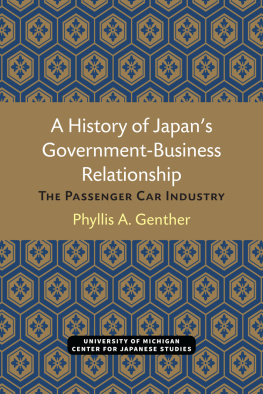CENTER FOR JAPANESE STUDIES
THE UNIVERSITY OF MICHIGAN
MICHIGAN PAPERS IN JAPANESE STUDIES
No. 20
A HISTORY OF JAPANS GOVERNMENT-BUSINESS RELATIONSHIP
The Passenger Car Industry
by
PHYLLIS A. GENTHER
Ann Arbor
Center for Japanese Studies
The University of Michigan
1990
Open access edition funded by the National Endowment for the Humanities/Andrew W. Mellon Foundation Humanities Open Book Program.
1990
Center for Japanese Studies
The University of Michigan
108 Lane Hall
Ann Arbor, MI 48109-1290
Library of Congress Cataloging-in-Publication Data
Genther, Phyllis Ann.
A history of Japans government-business relationship: the passenger car industry / by Phyllis A. Genther.
p. x, 242. cm. 23 (Michigan Papers in Japanese Studies : no 20) Thesis (doctoral)George Washington University. Includes bibliographical references.
ISBN 0-939512-40-8
1. Automobile Industry and tradeGovernment policyJapanHistory. I. Title. II. Series.
HD9710.J32G46 1990
338.4762920952dc20 89-77218 CIP
Index: AEIOU, Inc.
Printed in the United States
ISBN 978-0-939512-40-9 (paper)
ISBN 978-0-472-12807-5 (ebook)
ISBN 978-0-472-90207-1 (open access)
The text of this book is licensed under a Creative Commons Attribution-NonCommercial-NoDerivatives 4.0 International License: https://creativecommons.org/licenses/by-nc-nd/4.0/
CONTENTS
Interdependence between the United States and Japan increases daily and with it concern over the relative economic role of each country during the 1990s. As a result, the two countries will remain high on each others corporate and public policy agendas for the foreseeable future.
Concern increasingly is being expressed differently than in the past as the United States and Japan reach a new stage in their trade relationship. American domination of the relationship has ended, and overt Japanese tariff and nontariff barriers have been largely eliminated. The outstanding issues now revolve around deeper structural and cultural issues, including how industrial policies and government-business relationships affect global competitiveness and flexibility. At the beginning of the 1980s, it was the U.S.-Japan automobile crisis that presaged the new stage of bilateral trade relations by bringing the issue of industrial policy, and with it that of government-business relationships, to the forefront of the trade debate.
Despite the economic and political importance of the U.S.-Japan relationship and the extensive attention paid to automotive trade, few American scholars or policy makers are familiar with the history of Japanese government-business relations, either generally or for specific industries such as passenger cars. This book hopefully helps in a small way to fill that gap in our knowledge and, thus, to help strengthen the foundation from which we make public policy decisions about bilateral trade.
The few existing English-language books about the Japanese automobile industry contain little discussion of government-business relations. Japanese-language books contain even less. Michael Cusumanos book, The Japanese Automobile Industry, focuses primarily on the development of corporate strategies and technology. It is valuable in helping us understand how business positioned itself but tells us little about the formation of public policy. While C.S. Changs study, The Japanese Auto Industry and the U.S. Market, briefly discusses certain policy actions, it contains no framework of how Japan arrived at decisions. In addition, it does not cover the important events of the American Occupation. Other books such as William Duncans U.S.-Japan Automobile Diplomacy and David Halberstams The Reckoning provide useful information on particular aspects of the industrys history.
This book represents with some minor modifications my doctoral dissertation. I particularly acknowledge the support and guidance of Eleanor M. Hadley, to whom I owe the great majority of my knowledge about the Japanese economy. I am indebted to my other professors at George Washington University, especially Gaston Sigur and Benjamin Nimer, who helped oversee my dissertation. I also thank Takafusa Nakamura for sponsoring my study at the University of Tokyo and for allowing me to be part of his graduate seminar.
In addition, I am grateful for the support received from my friends and former colleagues at the Japan Economic Institute who generously allowed me the time necessary to pursue my doctorate and later provided needed workspace to write the original dissertation after I returned from Japan.
I also appreciate the generosity of many people in Japan who made my research possible: the Matsumoto and Takasaki families who allowed me to share their homes, Yoshio Nakamura and others at Keidanren, Kazuko Maekawa, Kyoko Nakamura, and Hiroshi Ando. Many individuals in the Japanese government, automobile industry, and academia willingly shared their time and knowledge with me.
My dissertation also could not have been completed without the support provided by a Fulbright Fellowship that funded my research in Japan. I am especially proud to have received one of the first two grants funded by the GARIOA/Fulbright Alumni Association of Japan. The Association for Asian Studies aided by providing a travel grant for research in Michigan.
During the 1980s, American policy makers repeatedly raised the issue of the Japanese government-business relationship as part of the industrial policy debate. Some portrayed the relationship as more effective than that of the United States and stressed the Japanese governments ability to intervene in, and restructure, the economy. At the same time, other policy makers continued staunchly to defend the separation of government and business as the essential ingredient of a strong market economy. They claimed that Japanese industrial policies with their special governmentbusiness relationship have been ineffective at best and counterproductive at worst. These opposing perceptions were used to help to justify both interventionist and free trade policies in the United States. By doing so, a debate arose over whether or not certain government-business relationships can provide advantages in global competition by making public policies more effective and business more competitive.
This book examines the debate by investigating interactions between the Japanese government and the Japanese automobile industry from the industrys origins to the implementation of voluntary restraints on automobile exports to the United States in 1981. It starts with the premise that government-business relationships exist and are far more complex than usually depicted by those who attempt to use them either to justify or to counter government intervention. It defines the relationships as institutional structures within which states and private companies interact and work together, or fail to work together, to formulate and implement commercial policy. It finds that, while relationships differ across nations and across industries within nations, the need to define competition globally necessitates understanding how and why specific interactions occur.
The Japanese automobile industrys experience adds to our understanding of the role and competitive implications of government- business relationships. This book sheds light on the effects of Japanese government and automobile industry interactions over time on Japanese economic development and thence on global competition.
Although there are inherent limitations in using a single industry to understand Japanese government-business relations overall, it is only possible to understand these complex interactions when individual industries are studied in enough detail to create a broad base of knowledge. And, it is the discovery of interactive patterns in individual industries through which the nature of government-business relationships are revealed.













